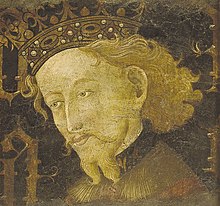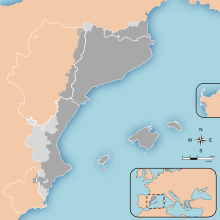Principality of Catalonia
Today, the term Principat (Principality) is used primarily to refer to the autonomous community of Catalonia in Spain, as distinct from the other Catalan Countries,[7][8] and usually including the historical region of Roussillon in Southern France.
The Catalan language flourished and expanded as more territories were added to the Crown, including Valencia, the Balearic Islands, Sardinia, Sicily, Naples, and Athens, constituting a thalassocracy across the Mediterranean.
After the surrender of Barcelona in 1714, King Philip V of Bourbon, inspired by the French model, imposed absolutism and a unifying administration across Spain, and enacted the Nueva Planta decrees for every realm of the Crown of Aragon, which suppressed the main Catalan, Aragonese, Valencian and Majorcan political institutions and rights and merged them into the Crown of Castile as provinces, ending their status as separate political entities.
These religious centers contribute to an important diffusion of the Romanesque art in Catalonia (monasteries of Santa Maria de Ripoll and Montserrat, collegiate church of Cardona, cathedral of Girona...) as well as to the maintenance of rich libraries nourished by Classical, Visigothic and Arab works.
The scholar and mathematician Gerbert d'Aurillac (future pope under the name of Sylvester II) studied in Vic and Ripoll and knowledge of mathematics and astronomy were introduced from Arabic.
[15] During the 9th and 10th centuries, the counties increasingly became a society of aloers, peasant proprietors of small, family-based farms, who lived by subsistence agriculture and owed no formal feudal allegiance.
At the start of the 11th century the Catalan Counties suffer an important process of feudalisation, as the miles formed links of vassalage over this previously independent peasantry.
[16] During the regency of countess Ermesinde of Carcassonne (1017–1057), which received the government of Barcelona after the death of her husband the count Ramon Borrell,[17] the disintegration of central power was evident.
[25] His son, King Peter II of Aragon, faced the defense of the Occitan territories, acquired from the times of Ramon Berenguer I onwards, from the Albigensian Crusade.
The Battle of Muret (12 September 1213) and the unexpected defeat of King Peter and his vassals and allies, the counts of Toulouse, Comminges and Foix, against the French–Crusader armies, resulted in the fading of the strong human, cultural and economic ties existing between the ancient territories of Catalonia and the Languedoc.
[27] This treaty confirmed, from French point of view, the independence of the Catalan counties established and exercised during the previous three centuries, but also meant the irremediable separation between the people of Catalonia and the Languedoc.
[37][38] The Catalan Company, mercenaries led by Roger de Flor and formed by Almogavar veterans of the War of the Sicilian Vespers, were hired by the Byzantine Empire to fight the Turks, defeating them in several battles.
After the assassination of Roger de Flor by orders of the emperor's son Michael Palaiologos (1305), the Company took revenge by sacking Byzantine territory, and they conquered the duchies of Athens and Neopatras in the name of the King of Aragon.
[41] The second quarter of the 14th century saw crucial changes for Catalonia, marked by a succession of natural catastrophes, demographic crises, stagnation and decline in the Catalan economy, and the rise of social tensions.
Meanwhile, the remença (serfs') peasants subjected to the feudal abuses known as evil customs began to organize themselves as a syndicate against seignorial pressures, seeking protection from the monarch.
In response of the detention of Charles by his father, the Generalitat established a political body, the Council of the Principality, with whom, under menace of a conflict, John was forced to negotiate.
However, the disagreement of King John, the death of Charles shortly after, and the Remença Uprising in 1462 led to the ten-year Catalan Civil War (1462–1472) that left the country exhausted.
Between the 16th and 18th centuries, the role of the political community in local affairs and the general government of the country was increased, while the royal powers remained relatively restricted, which was attested after the two last Courts (1701–1702 and 1705–1706).
[51] In 1626 the Count-Duke of Olivares, minister of Philip IV, tried to establish the military contribution of the states of the monarchy, the Unión de Armas (Union of Arms),[52] but the resistance of Catalonia to the project was strong.
This events, alongside other factors such as the economic crisis, the continuous presence of royal soldiers and the peasants' revolts led to the Reapers' War (1640–1652), in the context of the Franco-Spanish War, in which Catalonia, governed by a Junta de Braços (revolutionary assembly or States-General) led by the president of the Generalitat, Pau Claris, broke with the Spanish king and briefly established itself as an independent republic under French protection in 1641, and later entered in a personal union with the Kingdom of France, appointing French king Louis XIII as count of Barcelona,[53] but, after the first military successes, Catalans were finally defeated and reincorporated into the Crown of Spain in 1652.
[54] In 1659, after the Treaty of the Pyrenees signed by Philip IV of Spain, the comarques (counties) of Roussillon, Conflent, Vallespir and part of la Cerdanya, now known as French Cerdagne, were ceded to France.
[59] Previously, the same year, the Principality of Catalonia and the Kingdom of England signed the Pact of Genoa, receiving the first one protection to its institutions and liberties, entering in the pro-Habsburg Grand Alliance.
The victorious army of Philip V occupied the capital of Catalonia and (as happened to the kingdoms of Aragon and Valencia, also loyals to Charles) the king enacted the Nueva Planta decrees in 1716.
So late as in the 18th and 19th centuries, despite the military occupation, the imposition of high new taxes[63] and the political economy of the House of Bourbon, the Catalonia under Spanish administration (now as a province) continued the process of proto-industrialization, relatively helped at the end of the century from the beginning of open commerce to America and protectionist policies enacted by the Spanish government (although the policy of Spanish government during those times changed many times between free trade and protectionism), consolidating the new economic growth model that was taking place in Catalonia since the end of the 17th century, becoming a center of Spain's industrialization; to this day, it remains one of the more industrialized parts of Spain, along with Madrid and the Basque Country.
The terms Catalonia and Catalans were commonly used to refer to the territory in Northeastern Spain and western Mediterranean France, as well as its inhabitants, and not just the County of Barcelona, at least since the beginnings of the 12th century, as shown in the earliest recordings of these names in the Liber Maiolichinus (around 1117–1125).
[70] According to research carried out in recent decades, is considered to be in the second half of the 12th century when the Catalan counties form a unified and cohesive political entity, –although jurisdictionally divided– called "Catalonia".
The origins of the vegueria go back to the era of the Carolingian Empire, when vicars (Latin: vicarii, singular vicarius) were installed beneath the counts in the Marca Hispanica.
[80] The Usage Princeps namque, dating from the 11th century, regulated the defense of the prince and the Principality,[81] and became the basis of the organization of self-defense and paramilitary units throughout Catalan history, materialized in mutual-protection agreements known as Sagramental,[82] while the militia corps was known as Sometent.
Due to the outbreak of the Catalan Civil War (1462–1472), the Council of the Principality of Catalonia organised different military forces to fight against the King John II.
The novel of chivalry Tirant lo Blanc (1490), by Joanot Martorell, shows the transition from medieval to Renaissance values, something than can also be seen in the works of Bernat Metge and Andreu Febrer.

















